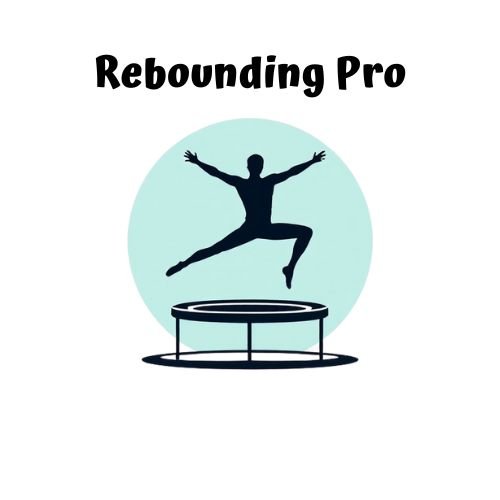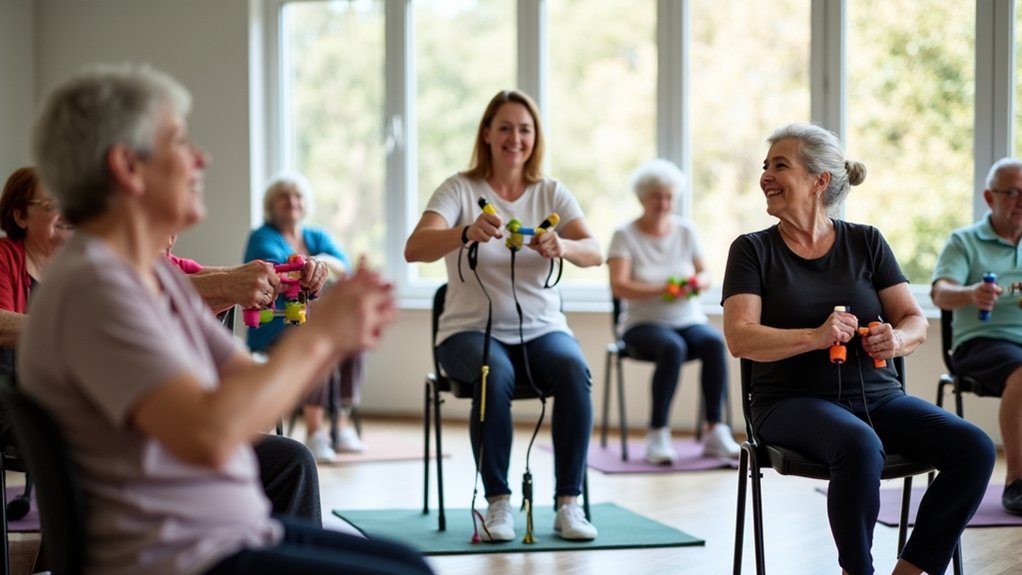Mini-trampolines offer effective relief for vertigo by gently stimulating your vestibular system through controlled bouncing. This low-impact exercise helps retrain your balance system, integrating sensory information and improving stability. Start with simple rebounds while holding a sturdy support, gradually increasing difficulty as your confidence grows. Many patients report significant improvements in both physical balance and emotional wellbeing. Properly structured rebounding programs can transform your recovery journey from fear to freedom in ways traditional exercises can’t match.
Understanding the Connection Between Mini-Trampolines and Vestibular Healing

When your world seems to spin out of control due to vertigo, mini-trampolines offer a surprisingly effective therapeutic solution.
These devices create an ideal environment for vestibular rehabilitation by stimulating your balance system through controlled, low-impact bouncing movements. The gentle bouncing motion directly engages your vestibular system, helping your brain reintegrate sensory information that’s disrupted during episodes of dizziness.
Research shows that patients with vestibular dysfunction who incorporate mini-trampolines into their therapy regimen experience improved postural stability and a reduced risk of falls.
What makes mini-trampolines particularly valuable is their adaptability—exercises can be tailored to your specific balance challenges, gradually increasing in difficulty as your vestibular system recovers.
This customized approach guarantees you’re consistently challenged while rebuilding confidence in your body’s ability to maintain equilibrium.
The Science Behind Rebounding Therapy for Balance Disorders
Beneath the bouncing surface of mini-trampolines lies a fascinating neurological process that explains their effectiveness in treating balance disorders. When you bounce, you’re actually retraining your vestibular function through controlled movement that challenges your balance system.
Mini-trampolines transform balance therapy by harnessing neurology—each bounce recalibrates your vestibular system through precisely controlled challenges.
- Each bounce stimulates your inner ear, helping your brain recalibrate its response to motion.
- The repetitive movement increases proprioceptive feedback, integrating multiple sensory inputs.
- Mini-trampolines create a safe environment to confront and overcome sensations of dizziness and spinning.
- Low-impact rebounding promotes neuroplasticity, rewiring neural pathways essential for balance.
Vestibular rehabilitation through rebounding works because it gradually exposes you to the very movements that trigger discomfort, allowing your brain to adapt and reduce symptoms over time—making these simple devices powerful tools for recovery.
Getting Started: Safe Rebounding Techniques for Vertigo Sufferers

Initiating a mini-trampoline routine as a vertigo sufferer requires careful preparation and technique to maximize benefits while minimizing risks.
Before beginning any vestibular recovery exercises, consult with your healthcare professional to verify mini-trampolines are appropriate for your specific condition.
Start by positioning your trampoline near a wall or sturdy chair for support. Stand with feet shoulder-width apart to establish a stable base.
Begin with gentle, controlled bounces that barely lift your feet from the surface. This minimal elevation prevents overwhelming your sensitive vestibular system.
As you progress, incorporate visual focusing techniques by fixing your gaze on a stationary object. For additional challenge, try brief moments with eyes closed to enhance proprioception.
Gradually increase intensity only as your balance improves, remembering that consistent, gentle rebounding often provides more vertigo relief than vigorous exercise.
Progressive Mini-Trampoline Exercises for Vestibular Adaptation
Progressing from basic rebounding, you’ll find sensory integration training particularly effective for retraining your brain to process balance signals correctly.
Through consistent mini-trampoline exercises, you’re actively challenging your vestibular system to adapt to various movement patterns and visual environments.
As your nervous system learns these new patterns, you’ll notice your balance confidence gradually returning, allowing you to participate more fully in daily activities that once triggered vertigo symptoms.
Sensory Integration Training
When your brain receives conflicting signals from the vestibular system, vertigo symptoms often result. Mini-trampolines offer an effective platform for sensory integration training that helps your brain process these signals more effectively, reducing dizziness and improving stability.
During vestibular rehabilitation, you’ll challenge multiple sensory systems simultaneously:
- Standing on the mini-trampoline’s unstable surface while focusing on a fixed point trains your vestibular system to adapt to conflicting sensory inputs.
- Performing gentle bounces with eyes closed enhances your brain’s ability to rely on proprioceptive feedback.
- Adding head movements while maintaining balance forces your vestibular system to process complex information.
- Gradually increasing difficulty helps your brain develop compensatory strategies for managing sensory conflicts.
This progressive approach helps you rebuild confidence in your balance while making vestibular adaptation more engaging and effective.
Balance Confidence Restoration
Individuals recovering from vertigo often struggle with a crippling loss of balance confidence that extends beyond physical symptoms.
Mini-trampoline exercises can greatly restore this confidence while providing effective vestibular adaptation. As you practice these gentle bouncing movements, your brain receives consistent proprioceptive feedback, helping recalibrate your balance system.
Physical therapy programs incorporating mini-trampolines offer progressive challenges that build confidence incrementally. These exercises involve starting with simple standing and gradually advancing to more dynamic movements as your stability improves.
The controlled environment reduces fall prevention anxiety while stimulating vestibular adaptation.
Research confirms that regular practice on mini-trampolines markedly improves postural control and reduces dizziness through habituation.
This restoration of balance confidence ultimately enhances your quality of life by enabling return to normal daily activities with renewed security.
Real Patient Success Stories: Rebounding Through Recovery

You’ll be inspired by patients who’ve transformed their lives with mini-trampoline therapy, moving from debilitating fear to newfound freedom.
Many who once couldn’t walk across a room without vertigo now confidently practice daily rebounding routines, regaining both physical balance and emotional well-being.
These success stories highlight how regular mini-trampoline exercises have empowered individuals to reclaim activities they’d abandoned, proving that persistence through progressive rebounding can lead to remarkable recovery.
From Fear to Freedom
Many vertigo sufferers initially approach mini-trampolines with trepidation, only to discover they become powerful tools for reclaiming independence.
As you progress through vestibular balance exercises, you’ll notice your fear of falling gradually diminishing, replaced by confidence in your body’s capabilities.
- Your residual dizziness decreases as your brain adapts to the dynamic movements
- Daily activities become less intimidating as you improve balance through consistent practice
- The gentle bouncing motion challenges your vestibular system without overwhelming it
- You’ll feel empowered as symptoms of vertigo become more manageable
The mini-trampoline transforms from an intimidating piece of equipment to a symbol of freedom.
Patients consistently report feeling liberated as they regain abilities previously limited by vertigo, enabling them to reconnect with hobbies and social activities they once enjoyed.
Rebounders Restoring Balance
Behind every statistic on mini-trampoline therapy lies a real person who’s reclaimed their life from vertigo’s grasp.
Patients using rebounders in vestibular rehabilitation consistently report significant improvements in their daily stability and reduced dizziness symptoms.
“After six weeks, I could walk through crowded spaces without fear,” shares one patient who integrated mini-trampolines into her recovery plan.
Another notes, “My core muscles strengthened, and I’ve regained confidence in my movements.”
These success stories highlight how regular rebounding exercises enhance proprioception—your body’s position awareness—creating lasting improvements in balance.
You’ll likely notice not just physical benefits but also renewed enjoyment in activities you once avoided.
The gentle bouncing motion specifically challenges your vestibular system in controlled, therapeutic ways that traditional exercises can’t match.
Complementary Practices to Enhance Your Rebounding Rehabilitation
While mini-trampoline exercises form the cornerstone of vestibular rehabilitation for many vertigo sufferers, combining them with complementary practices can greatly amplify your recovery progress.
As you work to improve your balance and reduce dizziness through proprioceptor stimulation, consider integrating these additional techniques into your routine:
- Balance-focused yoga poses that strengthen your core while challenging your vestibular system
- Guided visualization exercises during rebounding to enhance spatial awareness and fall prevention
- Tai Chi movements between mini-trampoline sessions to reinforce postural stability
- Breathing techniques that calm your nervous system when vestibular symptoms intensify
These complementary practices work synergistically with your rebounding exercises, creating a thorough approach to vestibular rehabilitation that addresses both physical and neurological aspects of balance disorders.
Frequently Asked Questions
Is Trampoline Good for Vestibular?
Trampolines are excellent for your vestibular system. They’ll challenge your balance, enhance proprioception, and improve coordination. You’ll experience reduced dizziness symptoms as you regularly engage in these dynamic movements on the unstable surface.
What Is the Best Treatment for Vestibular Vertigo?
The best treatment for vestibular vertigo depends on your specific condition. You’ll benefit from personalized VRT exercises, canalith repositioning maneuvers like Epley, and possibly temporary vestibular suppressants during acute episodes.
Can Rebounding Help With Vertigo?
Yes, rebounding can help with vertigo. You’ll benefit from the gentle vestibular stimulation, which improves your balance system’s function. Start slowly and gradually increase duration as your brain adapts to the movement.
How to Calm Down the Vestibular System?
To calm your vestibular system, try gentle head movements, focused breathing exercises, and maintain fixed gaze points. You’ll benefit from regular sleep patterns, staying hydrated, and limiting screen time before bed.
In Summary
You’ve now discovered a promising path to reclaiming your balance and confidence. By incorporating mini-trampoline rebounding into your vestibular rehabilitation routine, you’re actively retraining your brain to process motion differently. Start slowly, progress gradually, and you’ll likely notice improvements in your stability and reduced vertigo symptoms. Remember, consistency is key—your vestibular system strengthens with each gentle bounce you take toward recovery.





Leave a Reply